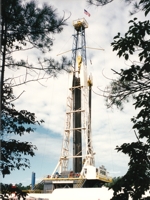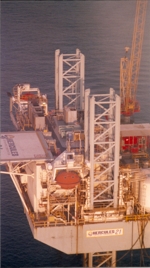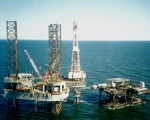
Smackover Discovery (AL)

OCS Discovery (SLA)

OCS Discovery (SLA)
PRESENTED HERE.
At the onset of the COVID-19 shelter-in-place quarantine, when we were all sheltering in place, oil prices were crashing, and LinkedIn was filled with the poignant posts of people who'd been laid off or forced into retirement, Steve Walkinshaw started his popular LinkedIn Oil Patch Quizzes. These quizzes were intended to distract everyone from the bad news that seemed everywhere in those challenging days. If these quizzes did distract you from all of the bad news out there - if only for a moment - then Steve will have succeeded in his efforts. These quizzes are reproduced here, for those of you who might not have seen their original postings on LinkedIn.
The subject for most of these quizzes is the "oil patch" - the upstream oil & gas community. That having been said, many quizzes also address other topics of geological interest. We hope you enjoy these quizzes.
Here are the answers to the quiz questions. You can return to the quiz questions by clicking here.
1. SOHIO #1 L.W. Magoun, Section 23-T7N-R7E, Concordia Parish, Louisiana. API 1702922156, Serial Number 188719.
2. Richland Gas Field
3. The Sunniland Oil Trend of South Florida, which produces from the Lower Cretaceous Sunniland Formation. There have been 14 fields discovered in the Sunniland Trend, including Sunniland Field, Florida's first oil discovery in September, 1943. The fields are oriented northwest/southeast along a trend that extends through Lee, Hendry, and Collier Counties (some extend the Trend further southeast into Dade County). The Sunniland crude oil gravity typically ranges from 26 to 28 degrees API.
4. Zero (the gas is food-grade carbon dioxide). Here's the name of that 261+ BCF gas well: Denbury Onshore, LLC #1 Pearl River 2-4, API #231212018501000, Section 2-T7N-R3E, Rankin County, Mississippi (Dri Ice Field; completed February 2008). Eight of the nine most prolific (100+ BCF) gas wells in Mississippi, as mentioned in the original post, produce food grade carbon dioxide, with hardly any impurities; the produced carbon dioxide of the Madison / Rankin County area of South-Central Mississippi is, on a trend-wide basis, believed to be the purest in the world.
5. Hackberry Embayment; probable unreported bolide impact.
6. Gilbertown Field, Choctaw County, Alabama.
7. Marathon Oil Company #1 Robert B. Todd et al, located in irregular Section 38-T1N-R6W, West Feliciana Parish, Louisiana; spudded October 27, 1982 and abandoned as a dry hole on January 16, 1983. The API number for the well is 17125200260000 and the state serial number is 183239. The well is located in Louisiana, not far from the Old River Control Structure, in the historic Turnbull Bend (Island) area. The Chalk was extensively cored in this legacy well.
8. The key South Alabama county that contributed greatly to our understanding of Norphlet seif dune fields is Choctaw County. The axes of the seif dunes in Choctaw County are oriented (current day) in a distinct northeast/southwest direction (further to the south, just offshore in the Mobile Bay area, a similar Norphlet seif dune field exhibits a more north/south axial orientation). A number of small Upper Smackover oil fields have been discovered atop the thickest axial crests of the underlying Norphlet seif dunes; most of these Smackover traps are stratigraphic traps formed by dolomitized oolite shoals (exhibiting classic oomoldic (high) porosity and (low) permeability) . The shoals accumulated in higher-energy, shallower wave base areas caused by paleotopographic drape over the thickest axial crests of certain dunes. The 2.1 MMBO / 2.3 BCF Silas Field is an excellent example of one such trap. The diamond core of the highly porous but poorly permeable oomoldic Upper Smackover reservoir cut in the discovery well for Silas Field was observed to be bleeding saltwater when it was retrieved form the core barrel. This is typical for such productive oomoldic reservoirs in the area.
9. Bromine
10. Winchester #1 Shieldsboro, located in Section 7, T4N-R3W, Adams County, Mississippi. The repeated Selma Chalk section has been identified and mapped on 3D seismic data acquired across the area. It appears to be a northeast/southwest - oriented thrusted block of chalk, of somewhat limited aerial extent, associated with transpression on the east side of a right-lateral strike-slip fault (the strike of which appears to be northwest/southeast). The rhombic-shaped tensional syncline that formed "behind" this thrusted block appears to have initiated the onset of a significant erosional event that impacted an area much larger than the original tensional syncline.
11. Phenomenal porosity (often exceeding 30%) and permeability has been encountered in a particular Paleozoic formation in the Black Warrior Basin (BWB) of Alabama and Mississippi. In many areas of the Basin, the lithology of this excellent reservoir rock has been described as a diagenetically-altered spongolite composed principally of leached sponge spicules. This reflects a remarkable time when vast reefal sponge communities flourished in shallow waters during a period of warm climate. It appears such widespread spongolite deposits are comprised of a trend of shallow-water sponge bioherms surrounded by large areas of reworked and redeposited spicule fragments (and other unrelated fossiliferous debris). This siliceous reservoir has also been commonly described as a tripolite that can reach thicknesses in excess of 200 feet. It has been underexplored in most of the Black Warrior Basin, despite its proximity to two important source rocks and the fact that it is very analogous to a prolific time-stratigraphic equivalent reservoir that produces in west Texas and elsewhere. What is the name of this leached spongolitic / tripolitic Paleozoic BWB reservoir (two word phrase)?
[More to follow...]